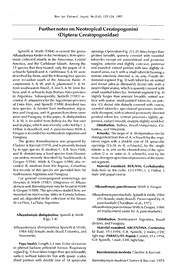
Further notes on Neotropical Ceratopogonini (Diptera: Ceratopogonidae) PDF
Preview Further notes on Neotropical Ceratopogonini (Diptera: Ceratopogonidae)
Reo.Soco Entomol. Argent. 56 (1-4): 123··124,1997 Furthernotes onNeotropical Ceratopogonini (Diptera:Ceratopogonidae) Spinelli & Wirth (1984) reviewed the genus openings.Operculum(Fig.2)1.25timeslongerthan AlluaudomyiaKiefferinthe Neotropics,fromspeci greatest breadth, sparsely covered with rounded mens collected mainly in the Amazonas, Central tubercles except on anterolateral and posterior America, and the Caribbean Islands.Among the margins; anterior end slightly concave, posterior 17 speciesthatthey treated, onlythe pupae of A. end rounded; central portionwith two slightly el schneckiSpinelliand A.caribbeana S.&W.were evatedareas,each with a small tuberclebearingél described by thern,and the followingfour species minute anteriorly directed a. m. seta. Fourth ab were recorded south of the Amazon Basin: A. dominal segment(Fig.3) with tubercleson ventral catarinensis S. & W. and A. plaumanni S. & W. and dorsal sides as illustrated; dorsal side with a from southeastern Brazil, A.leei S.& W.from Bo raised ellipticalarea,whichissparselycoveredwith livia, and A.schnackifrom BuenosAires province small rounded tubercles.Terminalsegment(Fig.4) in Argentina. Subsequently, Spinelli (1985) re slightly longer than anterior breadth; ventral sur corded A.amazonicaforthe Argentinianprovince face with sparse, small pointed tubercles on ante of Entre Ríos, and Spinelli (1988) described two rior 1/3; dorsal side densely covered with coarse, new species: A. biestroifrom northeastern Argen rounded tubercles; apicolateral processes moder tinaand Uruguay,and A.guaranifrom thesesame atelydivergent, with scattered posteriorlydirected areasand Paraguay. Inthis paper, A.distispinulosa pointed tubercles; ventraI processes tightly ap S. & W. is recorded from Bolivia for the firsttime pressed,surfacesmooth,marginsslightlywrinkled. and itspupa,whichwas recentlycollectedby L.J. Distribution. Bolivia, Brazil (Amazonas), Co Hribar, isdescribed,and A.punctivenosaWirth & lombia, and Venezuela. Grogan isrecordedfornortheasternArgentinaand Remarks. The pupa of A. distispinulosa can be Paraguay. distinguishedfrom thatofA.schneckibythe respi The genus Baeodasymyia was proposed by ratory organ with a double row of 18 spiracular Clastrier& Raccurt(1979),and ispresentlyknown openings (23-26 in A. schneckii, by the single by itstype-species B. modesta C. &R.from Haiti, minute a. m.seta on the elevated area oftheoper and B. dominicana, a fossil speciesfrom Domini culum (2 a. m. setae in A. schnacki), and by the can amber, recentlydescribed by Szadzieswski & moredivergentapicolateralprocessesofthe terrni Grogan (1994). Wirth & Grogan (1988) also re nal segmento corded B. modesta from Río Raposo, Colombia; Material examined. BOLIVIA. Cochabamba: first records of this species are provided here for Bulo Bulo nr. Río Leñe, 12-1-1995, L.J.Hribar,l northeastern Argentinaand Paraguay. malewith pupalexuvia. For general ceratopogonid terminology see Downes & Wirth (1981). Diagnoses of Alluau domyia and Baeodasymyiamay be found inWirth Alluaudomyia punctivenosa Wirth & Grogan & Grogan (1988).Thespecimensstudied hereare mountedon microscopeslides inCanada balsam, AlluaudomyiapunctiradialisSpinelli&Wirth, 1984: and are deposited in the collection ofthe Museo 692 (female, male; Brazil). Preoccupiedby A. de LaPlata, LaPlata,Argentina. punctiradialisChaudhuri etel., 1972. AlluaudomyiapunctivenosaWirth&Grogan,1988: 20 (replacementnamefor A.punctiradialis). Alluaudomyiadistispinulosa Spinelli & Wirth (Figs.1-4) Distribution. Northeastern Argentina, Brazil (Belern),and Paraguay. Alluaudomyia distispinulosa Spinelli & Wirth, Material examined.ARGENTINA. Corrientes: 1984:682(female,male;Brazil,Colombia,and Itá lbaté, 19-1-1994, G.R. Spinelli, 2 males, CDC Venezuela). lighttrap. PARAGUAY.Itapuá:Corateí,19-1-1994, G.R.Spinelli,1male,CDClighttrap. Pupa(male), Length 2.2 mm. Colorofexuviae in phenol balsam yellowish brown. Respiratory organ(Fig.1)fourtimeslongerthanapicalbreadth, Baeodasymyiamodesta Clastrier& Raccurt surface without tubercles but with sparse seales; distal portion with double row of18 spiracular Baeodasymyiamodesta Clastrier& Raccurt,1979: Reo. Soco Entomol.Argent.56(1-4), 1997 1 ..; ; ¿........•.... ~ ~. , ...... 3 dorsal Figs, 1-4. Alluaudomyia distispinulosa, male pupa. 1, Respiratory organ; 2, operculum; 3, 4th. abdominal segment; 4, terminal segment. Scalebar =0.1mm. 100 (female, male; Haiti): Wirth & Grogan, nidaepara laArgentina yUruguay. Rev.Soco 1988:23 (genericdiagnosis;Colombia). Entomo/.Argent. 44(1-4}: 160. SPINElll,G. R.1988.Two newspeciesof Neotro Distribution. Northeastern Argentina, Colom pical Alluaudomyia(Insecta,Diptera, Ceratopo bia,Haiti, and Paraguay. gonidae). Iheringia,ser.Zoo/. 68: 129-136. Material examined. ARGENTINA. Misiones: SPINElll,G. R.& W.W.Wirth. 1984.The Neotropi Posadas,arroyoZaimán,14-111-1994,G.R.Spinelli, cal predaceousmidgesofthe genus Alluaudo CDC lighttrap. PARAGUAY. Itapuá:Corateí, 17-1·· myia(Diptera:Ceratopogonidae). Proc.Entomo/. 1994,G.R.Spinelli,3females,CDC Iighttrap. Soc.Washington 86: 673-702. Szadzieswski,R.&W.L.Grogan,Ir. 1994. Biting midgesfrom Dominicanamber. 1.Anewfossil lITERATUREClTED speciesofBaeodasymyia (Diptera:Ceratopogo nidae). Proc. Entomo/.SocoWashington 96: CHAUDHURI,P.K.,S.K. DASGUPTA& D.K.CHAUDHURI. 219-229. 1972.BitingmidgesofthegenusAlluaudomyia WIRTH,W.W.& W.L.GROGAN,JR.1988. Thepreda Kieffer(Díptera:Ceratopogonidae)from India. ceousmidgesoftheWorld{Diptera:Ceratopo Orienta/lns. 6: 83-110. gonidae;tribeCeretopogonini). FloraandFauna ClASlRIER,J.&C.RACeURT.1979. Baeodasymyiamo handbook, nro. 4, ed. E.J.Brill. desta n. g., n. sp., de la Républiqued'Haiti (Diptera,Ceratopogonidae). Ann. Parasito/. Hum. Comp. 54: 99-104. SPINELLI,GUSTAVOR. DOWNES, A.J. & W.W.WIRTH. 1981.Chapter28. DepartamentoCientífico de Entomología, Ceratopogonidae. In:MeAlpine,J.F.et al.(eds.), Museode LaPlata,1900La Plata, ManualofNearetie Diptera, vol.1,pp.393-421. andInstitutodeLimnología"Dr.RaúlA.Ringuelet", SPINElll,G. R.1985. NuevascitasdeCeratopogo- C.C. 712,1900LaPlata,Argentina. 124
